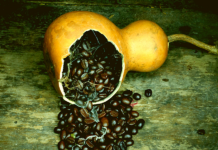Contents
Even if you’re cooking on a regular basis, the suggestion of sprinkling baking soda in coffee could make you raise an eyebrow. It is because baking soda is not that popular for such situations, particularly when used in beverages.
Although a bit odd, many people swear by its effectiveness, claiming that baking soda in coffee is easier on sensitive tummies.
Why though?
Today, we will be looking at the science and explaining why a sprinkle of baking soda in coffee can be a great thing.
Coffee Is Acidic
Coffee beans contain about 850 compounds that contribute to the unique aroma and taste of the coffee. When talking about coffee acidity, we do not necessarily mean an acrid or sour taste.
Sour coffee is usually the result of poor extraction, and that is another topic. Acidity is measured via the pH scale.
Some facts:
- A pH level of 7 is natural.
- Values up to 14 are alkaline while values lower than 7 are considered acidic.
- Coffees range about 5 with some light roasts staying in the 4.7 range.
- In comparison, tomato juice is at 4 while orange juice is a 3.
Read More:
- Best Lipton Iced Teas
- Best Decaf Coffee: All You Need to Know About Decaf Coffee
- 10 Best Low Acid Coffee Brands Review
- Ninja Hot and Cold Brewed System Review
- Best Brazilian Coffee
Factors Affecting The Coffee Acidity
So, while coffee is fairly high in the pH scale, why does some coffee are highly acidic while others don’t? Well, here are some factors affecting the acidity of coffee.


1) Growing Conditions
The growing conditions of the coffee beans play a huge role in the acidity of the brewed coffee. The mineral contents in the soil have a huge impact on this. The less acidic the soil is, then the less acidic the final product will be.
Coffee from countries such as Indonesia and Brazil tend to be less acidic than other growing regions, however, this is not a permanent rule.
In general, however, acidic coffee tends to come from volcanic soil and/or high elevation areas such as Ethiopia, Peru, and Guatemala.
2) Harvesting and Processing
Once the coffee cherries are picked, they’re usually processed 1 of 3 ways:
- Dry processing (aka natural processing)
- Wet processing (aka washed processing)
- Hybrid of the two
Although the processing method has a minimal impact on the pH, among the three, a wet-processed coffee usually tastes more acidic than the dry process. This is because dry-processed coffee usually has a stronger body that helps masks the acidic flavor. Read Here: Best Medium Roast Coffees
3) Roasting Method
Roasting has a significant impact on coffee acidity. The lighter roasts have higher acidity while the darker roasts neutralize or “burns off” the acid in the beans.
And while roasting for longer reduces the acidity level, roasting at higher temperatures also further reduces acidity. For instance, dark roasted beans at 410 degrees Fahrenheit will be more acidic than the same roast at 500 degrees Fahrenheit.
4) Brewing Method
The brewing method you use also affects the acidity of your coffee. Coffee brewed using a fine grind such as an AeroPress or a standard drip brewer usually has less acidity.
Coffee prepared with a coarser grind such as French press, on the other hand, yields a fairly acidic coffee. Also, the lack of paper filters, that would otherwise absorb some acid, also plays a role.
Water temperature also plays a huge role in coffee acidity, with higher water temperature has the ability to extract more acids, while lower temperatures extract less acid.
Coffee Acids Are Not That Bad
Not all acids in your coffee are bad. For instance, malic acid and phosphoric acid can make your coffee taste sweeter. Meanwhile, other acids such as acetic acid and citric acid offer tartness in low concentration but can also produce the sour taste in excess.
Chlorogenic acid, although may sound frightening, can contribute to weight loss, and adds much of the bitterness that coffee drinkers perceive as the coffee acidity.
A longer roasting process tends to break down this acid. It is all about finding the right acidity balance— one of the keys to a great-tasting coffee.
Acidity complements or unbalances the harmony of coffee. If it is too pronounced, it becomes sour. Without acidity, the coffee tastes flat.
Read More:
- Best Lipton Iced Teas
- Best Decaf Coffee: All You Need to Know About Decaf Coffee
- 10 Best Low Acid Coffee Brands Review
- Ninja Hot and Cold Brewed System Review
- Best Brazilian Coffee
The Negatives of Coffee Acid


Some people tend to experience discomfort after drinking coffee. This is often attributed to the acidity of the drink.
For one, quinic acid which is produced as the coffee degrades provides the burned and bitter flavor of coffee, which also has negative side effects on your digestive system.
Some acids can be very hard on sensitive stomachs, especially for those drinking more than a cup of joe every day. However, in most cases, it is not the coffee acidity causing problems but the caffeine which stimulates the production of your stomach acid.
Individuals sensitive to caffeine can experience heartburn since this compound can relax the muscles of your esophagus which results in acid reflux.
Baking Soda Is Alkaline
So, for the tummy-sensitive folks, acidic coffee can be a problem, especially if you can’t function properly without sipping on an energizing cup of coffee.
So, what do you do?
Try sprinkling baking soda in coffee.
Why?!
Well, baking soda is alkaline. It helps neutralize some of the naturally occurring acids in your cup of joe.
As a matter of fact, just ¼ teaspoon of baking soda for a whole pot of coffee can immediately smoothen the harsh flavor of a cheap coffee and making it easier for you to digest.
The best part?
Baking soda has no detachable flavor in your cup of coffee.
Other than those, baking soda also has surprising benefits that would make you want to start adding baking soda in coffee today!
- Prevent heartburn or acid reflux.
If you’re one to consume a cup of joe every chance you get, then you might be familiar with that rising feeling of acidity or heartburn. This usually comes with your daily fix of a cup of caffeine.
Specifically, heartburn is often associated with having cheap coffee or the medium roasted coffees.
Sprinkling baking soda in coffee can help overcome the coffee’s acidity, leaving you with nothing but the distinct kick that is associated with coffees. This is because of its alkaline properties that neutralize the excess stomach acid causing symptoms.
- Stops Stomach Pain
For those with a sensitive stomach, drinking coffee can also cause unwanted stomach pain. This is quite common for those with even a shot of espresso triggering serious stomach pain.
Baking soda in coffee can help prevent this, soothing your stomach against the acidic agents, provides you with a timely relief and making coffee drinking more bearable, especially if you’re suffering from a stomach ulcer.
- Help Relieve Gout
A form of inflammatory arthritis, gout occurs in some people with high uric acid levels in their blood. This acid can create painful needle-like crystals in your joint and causes severe episodes of redness, tenderness, swelling, pain, and warmth.
Thanks to the pH neutralizing effects of baking soda, it can help in lowering uric acid levels. Baking soda that is introduced to the blood can help alkalize it, causing the uric acid to break up then easily and quickly filter out by the kidney and expelled.
And the easiest way to introduce baking soda to your system is by sprinkling it in your coffee, which also helps reduce the acidity of your coffee that can worsen gout.
Read More:
- Best Lipton Iced Teas
- Best Decaf Coffee: All You Need to Know About Decaf Coffee
- 10 Best Low Acid Coffee Brands Review
- Ninja Hot and Cold Brewed System Review
- Best Brazilian Coffee
Baking Soda Side Effects
Now that you know the benefits and why some people are sprinkling baking soda in coffee, let’s talk about how the potential benefits.
Although large quantities of baking soda can help with indigestion, in much the same way antacids, you can go overboard and risk some unwanted side effects.
Think of drinking baking soda as drinking saltwater.
It is high in sodium, raising your blood pressure. And too much sodium is also associated with heart and kidney issues.
In addition, too much baking soda in coffee can leave you with a less flavorful cup leaving you a soapy taste in the mouth. In general, to reduce the acidity of coffee, you only need a small pinch in your coffee.
Other Ways To Reduce Coffee Acidity


So, other than baking soda, there are other ways you can do to ensure that you’re consuming fewer coffee acids.
1) Choose Low Acid Coffee
There are a few coffee brands that treat coffee beans so that the final product will have less acid without compromising flavors.
By roasting the coffee beans real slow, or interrupting the roasting process, the amount of acidity in each coffee bean is dramatically reduced.
Another method used by low acid coffee brands is the removal of the waxy outer layer of the beans before roasting. The end product will have full flavor but is less likely to cause upset stomach or acid reflux.
The only downside of these methods is that the coffee beans become less aromatic.
2) Cold Brewing
Cold brew is becoming more and more popular with coffee drinkers. It produces coffee with less bitter and more rounded taste and is also favored by most people with digestive issues and acid reflux.
This is because cold brewing can effectively neutralize coffee acids. As mentioned before the lower brewing temperature you use, the less acidity is extracted from the coffee bean.
Cold brew coffee has about 70 percent less acid that your regular piping hot cup of coffee.
3) Choose The Dark Roast
In terms of choosing a low-acid coffee bean for you to brew, it is all about the roasting process. Coffee beans start out as little green beans, with the roasting process determining its final color and the amount of acidity retained.
As mentioned before, the light and fruity-rich roasts may taste mild, however, they also have a higher amount of acidity. Thus, a darker bean is your best option for a happy tummy.
And it is not just the acid in your coffee that you need to worry about. Digestion requires the body to secrete acid and the coffee roast also has an impact on how much stomach acid is produced.
A 2014 study shows that volunteers who consumed a dark roast coffee experienced lower production of gastric acid than those who drank the medium roast.
Thus, the darker the roast, the lower its acid profile and fewer chances of over secreting gastric acid.
4) Add Milk
Another method in order to reduce the acidity levels of your coffee is just adding cream or milk. Milk also helps in balancing out the pH levels.
Light coffee roasts tend to take milk less well, mainly because of the high acidity levels. This is particularly true for soy milk since it curdles in acidic coffee.
So, in addition to getting along with dark roasts, you can have the freedom to add a splash of cream in your coffee in order to help tone down the acidity.
5) Egg Shells
Like sprinkling baking soda in coffee, adding eggshells while brewing your coffee might seem off, but actually works.
Eggshells are alkaline, thus neutralizing acid. Not only that, but eggshells can also help in reducing the bitter taste of coffee as a result of your brewing method or the type of roast you choose.
To use eggshells, clean, crush, and put the eggshells into your coffee maker, placing it into the chamber or basket with the coffee grounds. Brew as you normally would, and you will find the taste of your coffee to be cleaner and less acidic.
6) Salt
A dash of salt is usually added to coffee grounds before or after brewing in order to smoothen out the flavor of acidity or reduce the bitterness of coffee.
Read More:
- Best Lipton Iced Teas
- Best Decaf Coffee: All You Need to Know About Decaf Coffee
- 10 Best Low Acid Coffee Brands Review
- Ninja Hot and Cold Brewed System Review
- Best Brazilian Coffee
Conclusion
So, there you have it!
The idea of baking soda in coffee may sound weird, however, its health benefits explain why this is becoming a more popular thing to do these days.
And while you can’t completely remove the acidity of coffee, using baking soda and other alternatives can help tame that prominent flavor and allow you to enjoy a cup of joe or two without upsetting your stomach.













![Top 10 Best 2 Way Coffee Maker: [Buying Guide] best 2 Way Coffee Maker](https://bestdecafcoffee.com/wp-content/uploads/2020/09/DYSON-44-100x70.png)



